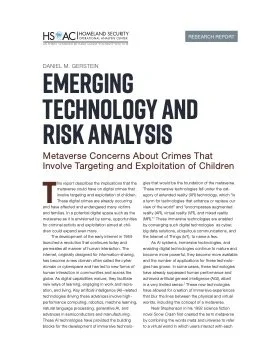By Daniel M. Gerstein
his report is one in a series of analyses on the effects of emerging technologies on U.S. Department of Homeland Security (DHS) missions and capabilities. As part of this work, the research team was charged with developing a technology and risk assessment methodology for evaluating emerging technologies and understanding their implications in a homeland security context. The methodology and analyses provide a basis for DHS to better understand the emerging technologies and the risks presented.
This report describes the implications that the metaverse could have on digital crimes that involve the targeting and exploitation of children. These digital crimes are already occurring and have affected and endangered many victims and families. In an immersive online environment, such as the metaverse, opportunities for criminal activity and exploitation aimed at children could expand further.
Key Findings
Metaverse technologies — which encompass artificial intelligence systems, immersive technologies, and enabling digital technologies — will likely continue to become more available, have greater capabilities, and cost less to obtain and use. As has been the case with other digital technologies, metaverse technologies likely will have few policy, legal, ethical, or regulatory impediments constraining their development or use.
The metaverse concept is at an inflection point. How it will expand, how large it will become, and whether will it become an expansive virtual world that directly competes with the physical world remain unanswered questions. The timelines for expansion of the metaverse also remain speculative and will largely depend on use case, demand, and market forces.
Both non-metaverse and metaverse platforms have been and will continue to be used effectively to target children. Furthermore, an overlap exists between non-metaverse and metaverse platform use in luring and victimizing children, which makes it impossible to delineate the share of these abhorrent behaviors ascribable to each.
The lack of legal frameworks for crimes involving the targeting and exploitation of children in online applications will likely continue to be an issue. Clear definitions for what constitute attacks in the metaverse are not available as they are in the physical world, which hinders investigations and prosecutions. Despite the known vulnerabilities and consequences, these platforms continue to be aggressively marketed to children.
As the metaverse grows, the potential of these platforms for targeting, luring, exploiting, and victimizing children through targeted criminal activity or child exploitation will likely also grow.
Santa Monica, CA: RAND, 2025. 24p.



